10 ways to tell if you are gluten intolerant

What you need to know:
- Gluten intolerance can be managed with a few dietary tweaks.
- It is important to see a doctor in order to rule out Celiac disease.
- All wheat products contain gluten.
Most people may not be aware that they are gluten intolerant because the symptoms may be mild or not noticeable at all. For some, however, the symptoms can be severe and even life-threatening.
Gluten is a protein found in wheat, barley, and rye. It is responsible for the elastic texture of the dough and helps it rise.
Gluten is also responsible for the chewy texture of pasta and the fluffy texture of pancakes. It is found in many processed foods such as cookies, crackers, and cakes.
Unfortunately, some people are allergic to gluten, and others have trouble digesting it.
Gluten intolerance
Gluten intolerance is a condition in which people experience symptoms after eating foods containing gluten but do not test positive for Celiac disease. When gluten intolerant people consume gluten, the body cannot digest it, causing a range of symptoms.
Symptoms
Gluten intolerance symptoms can vary from person to person, and range from mild to severe.
Here are 10 common symptoms of gluten intolerance:
- Bloating: This is one of the most common symptoms of gluten intolerance. After eating foods that contain gluten, you may feel uncomfortably full and gassy.
- Diarrhea.
- Constipation.
- Abdominal pain can be a symptom of Celiac disease and/or gluten intolerance.
- Nausea: Feeling nauseous after eating foods with gluten is another common sign.
- Fatigue: Gluten-intolerant people often feel tired and run down, even after a good night's sleep.
- Headaches: For some people, headaches and migraines are a symptom of gluten intolerance.
- Anaemia is a common symptom of Celiac disease but can also be seen in people with non-Celiac gluten sensitivity.
- Skin rash: A skin rash, called dermatitis herpetiformis, is a common symptom of Celiac disease.
- Joint pain and stiffness are often seen in people with gluten intolerance.
Difference between gluten intolerance and Celiac disease
Celiac disease is an autoimmune disorder in which the body attacks the gluten protein, damaging the small intestine lining. This can lead to a host of other health problems, such as diarrhoea, and anemia. Gluten intolerance does not damage the lining of the intestine but can still cause inflammation and other symptoms.
Difference between gluten intolerance and wheat allergy
A wheat allergy is a reaction to the proteins in wheat, not just gluten. This can cause symptoms such as hives, difficulty breathing, nausea, vomiting, diarrhea, and mouth swelling. Wheat allergies are often confused with Celiac disease or gluten intolerance, but they are different conditions.
Diagnosing gluten intolerance
Currently, there is no specific tests that can diagnose gluten intolerance. However, a doctor may start with a physical exam and a review of your symptoms. They may also order blood tests to look for antibodies that indicate an immune reaction to gluten.
A small intestine biopsy may also be done to rule out Celiac disease. In this test, a sample of the small intestine is taken and examined for damage.
Foods to avoid
If you have gluten intolerance, you will need to avoid all foods that contain gluten. These include:
* wheat
* barley
* rye
* bread
* pasta
* crackers
* cookies
* cakes
* pies
* soups
* sauces
* salad dressings
* gravies
Foods to eat
While there is no cure for gluten intolerance, the condition can be managed by following a gluten-free diet. This diet eliminates all foods that contain gluten. Fortunately, there are many delicious and healthy gluten-free foods to choose from. Gluten-free grains include rice, corn, quinoa, fruits, and vegetables.
Other foods safe to consume include meat, poultry, fish, gluten-free bread, pasta, beers, and wines.
Living with gluten intolerance
If you have been diagnosed with gluten intolerance, the best thing you can do is to avoid all gluten-containing foods. This may take some time to get used to, but many resources are available to help you transition, including cookbooks and online forums. Many delicious gluten-free foods are also functional, so you don't have to feel like you're missing out. With a bit of time and effort, you can easily adapt to a gluten-free diet.
If you think you may have gluten intolerance, talk to your doctor. They can help you get an accurate diagnosis and provide information and resources to help you transition to a gluten-free diet.
Gluten intolerant people may still get symptoms if they try a gluten diet even after avoiding it for some days. Therefore, it is incurable but manageable.




